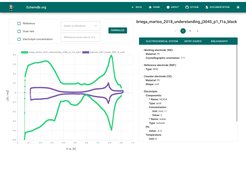New synergy between the Fritz Haber Institute and the Berliner Hochschule für Technik to foster innovation in science education
The Fritz Haber Institute is pleased to announce the successful conclusion of two collaborative projects with the Berliner Hochschule für Technik (BHT). During winter semester 2023/2024, two groups of master´s students in Computer Science for Digital Media from BHT, supported by colleagues of the Theory Department and their coordinator, BHT guest lecturer Heinz Junkes, have worked on meliorating tools for visualization and analysis of scientific data, alongside with improving accessibility to server-based scientific simulations.
The collaborative projects proved to be invaluable experiences for the students, representing one of the first opportunities in their educational journey to engage with a scientific and academic setting. The immersive environment not only allowed them to apply the previously acquired knowledge, but also to continue cultivating their skills while facing the complexity of practical applications. In addition to gaining exposure to the scientific environment, the experience was highly beneficial to develop essential soft skills that might prove fundamental in the professional arena: such as efficiently manage a project and learning how to meet deadlines while striving to fulfill needs and requirements of the customers.

The first project focused on the development of an interactive webpage to visualize and analyse theoretical and experimental Cyclic Voltammogram data and was carried out in collaboration with the group of Dr. Nicolas Hörmann. Cyclic Voltammetry is a widely used electrochemical technique that provides valuable insights into the behaviour of materials in various environments. The collaboration resulted in the creation of a user-friendly platform that facilitates the interpretation of complex data, thereby advancing research.
The second project centered around the development of an interactive web frontend for server-based scientific simulations and involved two groups respectively: Dr. Christoph Scheurer´s and Dr. Sebastian Matera´s. The interface aims at visualizing kinetic Monte Carlo models faster and in a more user-friendly way. Although initially envisioned for usage in the context of heterogenous catalysis, its versatility extends beyond, finding applications in diverse fields.
By leveraging the expertise of both institutions, the students were able on one side to design dynamic and intuitive interfaces that allow users to interact with simulations in real-time and on the other to efficiently display and analyze data from multiple sources.

These innovative approaches not only simplify the process of illustrating simulations and displaying data, but also open up new possibilities for educational outreach and scientific exploration.
Both projects culminated in a final presentation at BHT, where the students showcased their work and were evaluated based on their performance. The experience was highly rewarding for all parties involved, fostering collaboration, creativity, and learning. Plans for the next semester are already in the making and the Institute is looking forward to welcome more groups from BHT in the future.
The students say:
Our collaboration on the interactive Cyclic Voltammogram website project blending multiple fields of knowledge has been rewarding. We overcame challenges through effective communication, bridging the gap between software development and chemistry. This led to shared learning, expanding our horizons on both disciplines, while also encouraging innovative problem-solving. Our website, a product of diverse skill sets, makes electrochemical data accessible and provides tools for analysis and decision making. This collaboration highlights the power of teamwork, adaptability, and interdisciplinary synergy. Overall, it's been an impactful experience shaping our future endeavours, and we are proud of our achievements.













